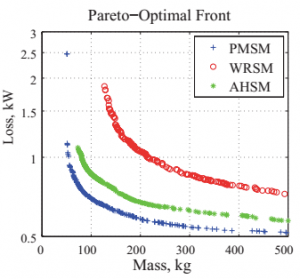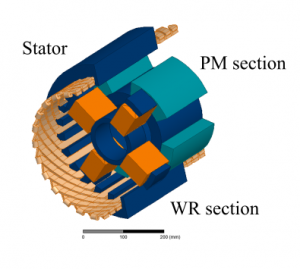Hybrid Machines for DC Generation
Steven Pekarek and Omar Laldin – Purdue University
The goal is to develop electric machine topologies utilizing a field winding and permanent magnets, to be used in conjunction with passive rectifiers. New hybrid topologies enable the benefits of both sources, including low-mass, low-loss, robust, and regulated dc generation systems. The topologies are compared using a population-based, multi-objective design process, from which the non-dominated designs (i.e., the Pareto-optimal fronts) are established.
A 60 kW, 1800 rpm generator supplying a constant power load at three different operating points was considered. The Pareto-optimal fronts for the wound rotor synchronous machine (WRSM), permanent magnet synchronous machine (PMSM) and axial hybrid synchronous machine (AHSM) obtained using 25 design variables are presented in Fig. 2. The fronts indicate the weighted average loss vs. mass trade-off for each topology. In general, the AHSM offers substantial reductions in loss compared to the WRSM over the mass range. For example, at 1 kW weighted average loss, the AHSM offers a 60% reduction in mass. An example AHSM design is shown in Fig. 3. It is noted that the rotor is primarily comprised of a permanent magnet (PM) section, with a wound rotor (WR) section providing the flux necessary to regulate the output voltage.
This research is supported by the Grainger Center for Electric Machinery and Electromechanics.

